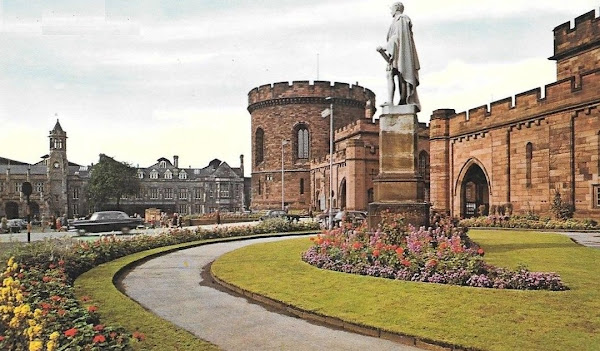I don’t often visit Carlisle, the largest conurbation in Cumbria and the county’s only city, unless I have an appointment of some kind. That was certainly the case a few days ago, when Paula had a routine medical appointment at the Cumberland Infirmary. We thought that it would be a chance to look around, because I knew that there were one or two places of interest.
On our way back to the city centre, the first point of interest that we encountered was a church that appears to function no longer as a place of worship:
We then followed the outside of what remains of the mediæval city walls:
There were a couple of stone plaques set into the wall, which suggests that these walls were rebuilt at some time in the nineteenth century:
We eventually found a flight of steps that leads to the city’s cathedral. There has been a cathedral on this site since the twelfth century, although I am unable to say how much of the structure that you can see today dates back to this period. The architectural style is Gothic, but when we went inside, I couldn’t help but notice several Romanesque arches at ground level in the area directly beneath the bell tower.
Here are two photos taken inside the cathedral:
The first, taken by Paula, shows the cathedral’s organ, while the second shows the east window. This is what the east window looks like from the outside:
…and these are two other views of the building:
While we were photographing the outside of the building, several people asked us whether we’d seen the policeman. It took us a while to find him, but you can see him in the following photo, a finial on the end of the architrave above the window:
Apparently, this finial commemorates the first policeman ever to lose his life in the line of duty.
All the external shots of the cathedral were taken by Paula.
Having seen everything there is to see in the vicinity of the cathedral, it was time to find somewhere to eat. Paula said that she’d seen some dining places next to ‘the castle’. We’d walked past Carlisle Castle on our way from the bus station to the hospital, and it wasn’t too far away. I didn’t recall seeing anywhere thereabouts to eat, but we headed in that direction anyway. I didn’t realize that when Paula had said ‘the castle’, she was actually referring to the city’s law courts, which are located next to the railway station. You can see the station in the background in the next photo, and you can also see why Paula thought that the law courts were actually a ‘castle’, with their crenellated walls and general quasi-mediæval appearance:
Meanwhile, we walked through Bitt’s Park, the largest urban park in the city, where I spotted these two mosaic ‘armchairs’:
Finally, on our way back to the city centre, we passed a spectacular mural:
It appears to show a Roman gladiator battling an unspeakable demon, although I do wonder whether it is allegorical, and that what you can see is an ordinary Roman soldier fighting off one of the barbarians that lived to the north and repeatedly raided the area south of the nominal border at the time (Emperor Hadrian had a wall constructed from coast to coast to keep out the aforementioned barbarians).
While I was photographing the mural, a woman walking past said this:
“Brilliant, isn’t it? It was painted by a student at the local art college.”
I couldn’t find a signature on the mural, but I agree with the woman’s assessment. I’ve recorded quite a lot of street art in Hong Kong, but this mural is even more impressive than anything I’ve seen there (cf. Tunnel Vision; Down by the Riverside; Latest News from Ghost Alley #2; Fish out of Water).
And that was our brief tour of Carlisle. We found somewhere for a late lunch, then caught the next bus back to Penrith.
Subscribe to:
Post Comments (Atom)






















The mural looks very recent. It's certainly not the sort of thing I would have expected to find in Carlisle. Incidentally, I notice that both the gladiator and the demon(?) are "southpaws", which is unusual.
ReplyDeleteThe mural surprised me too. And I didn’t spot that both combatants were left-handers either. Thanks for pointing that out.
DeleteIt CERTAINLY was a pleasant walk and discovery!!!!!
ReplyDeleteYes indeed!
Delete